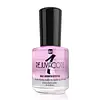What's inside
What's inside
 Key Ingredients
Key Ingredients

 Concerns
Concerns

 Ingredients Side-by-side
Ingredients Side-by-side

Butyl Acetate
MaskingEthyl Acetate
PerfumingNitrocellulose
Acetyl Tributyl Citrate
MaskingAdipic Acid/Neopentyl Glycol/Trimellitic Anhydride Copolymer
Isopropyl Alcohol
SolventAcid Yellow 23 Aluminum Lake
Stearalkonium Bentonite
Gel FormingAcrylates Copolymer
Titanium Dioxide
Cosmetic ColorantStyrene/Acrylates Copolymer
Silica
AbrasiveBenzophenone-1
UV AbsorberTrimethylpentanediyl Dibenzoate
Methoxyisopropyl Acetate
SolventPhosphoric Acid
BufferingCI 77510
Cosmetic ColorantDiacetone Alcohol
MaskingCI 77499
Cosmetic ColorantButyl Acetate, Ethyl Acetate, Nitrocellulose, Acetyl Tributyl Citrate, Adipic Acid/Neopentyl Glycol/Trimellitic Anhydride Copolymer, Isopropyl Alcohol, Acid Yellow 23 Aluminum Lake, Stearalkonium Bentonite, Acrylates Copolymer, Titanium Dioxide, Styrene/Acrylates Copolymer, Silica, Benzophenone-1, Trimethylpentanediyl Dibenzoate, Methoxyisopropyl Acetate, Phosphoric Acid, CI 77510, Diacetone Alcohol, CI 77499
Butyl Acetate
MaskingEthyl Acetate
PerfumingNitrocellulose
Adipic Acid/Neopentyl Glycol Copolymer
Skin ConditioningGlycol
HumectantVp/Va Copolymer
Acetyl Tributyl Citrate
MaskingSilica
AbrasiveTitanium Dioxide
Cosmetic ColorantIsopropyl Alcohol
SolventStearalkonium Bentonite
Gel FormingN-Butyl Alcohol
PerfumingAcrylates Copolymer
Benzophenone-1
UV AbsorberStyrene/Acrylates Copolymer
Diacetone Alcohol
MaskingPhosphoric Acid
BufferingCI 19140
Cosmetic ColorantTrimethylpentanediyl Dibenzoate
Hydroxyethyl Acrylate/Ipdi/PPG-15 Glyceryl Ether Copolymer
CI 15850
Cosmetic ColorantCI 12085
Cosmetic ColorantBlue 1 Lake
Cosmetic ColorantCI 77499
Cosmetic ColorantUltramarines
CI 77510
Cosmetic ColorantCI 77491
Cosmetic ColorantTin Oxide
AbrasiveButyl Acetate, Ethyl Acetate, Nitrocellulose, Adipic Acid/Neopentyl Glycol Copolymer, Glycol, Vp/Va Copolymer, Acetyl Tributyl Citrate, Silica, Titanium Dioxide, Isopropyl Alcohol, Stearalkonium Bentonite, N-Butyl Alcohol, Acrylates Copolymer, Benzophenone-1, Styrene/Acrylates Copolymer, Diacetone Alcohol, Phosphoric Acid, CI 19140, Trimethylpentanediyl Dibenzoate, Hydroxyethyl Acrylate/Ipdi/PPG-15 Glyceryl Ether Copolymer, CI 15850, CI 12085, Blue 1 Lake, CI 77499, Ultramarines, CI 77510, CI 77491, Tin Oxide
 Reviews
Reviews

Ingredients Explained
These ingredients are found in both products.
Ingredients higher up in an ingredient list are typically present in a larger amount.
Acetyl Tributyl Citrate is a fragrance.
Acrylates Copolymer is used as a film-forming agent and texture enhancer.
After applied, Acrylates Copolymer forms a thin film cover that helps skin feel more soft. It can help sunscreens become more water-resistant.
It is also used to make a product more thick.
Learn more about Acrylates CopolymerBenzophenone-1 absorbs UV.
We don't have a description for Butyl Acetate yet.
Ci 77499 is also hydrated iron III oxide. It is created from mixing red and black iron oxides. This helps give shades of darkness to a product.
Iron III oxides are classified as inorganic chemicals for coloring.
This ingredient is used to impart a blue color. It is not water-soluble.
It goes by two different names:
1. Ferric Ferrocyanide: a synthetic dark blue pigment
2. Ferric Ammonium Ferrocyanide: a synthetic blue pigment, also called Prussian blue
In the EU, both of these colors must be labeled as 'CI 77510'.
Learn more about CI 77510We don't have a description for Diacetone Alcohol yet.
Ethyl Acetate is a fragrance.
Isopropyl Alcohol is more commonly known as rubbing alcohol. It is most commonly used as a solvent, meaning it helps other ingredients dissolve.
This ingredient is an astringent alcohol. Astringent alcohols may also irritate skin as they high amounts may strip away your skin's natural oils.
Other types of astringent alcohols include:
According to the National Rosacea Society based in the US, you should be mindful of products with these alcohols in the top half of ingredients.
Any type of sanitizing product will have high amounts of alcohol to help kill bacteria and viruses.
Learn more about Isopropyl AlcoholWe don't have a description for Nitrocellulose yet.
Phosphoric acid is used to adjust the pH of products.
Silica, also known as silicon dioxide, is a naturally occurring mineral. It is used as a fine, spherical, and porous powder in cosmetics.
Though it has exfoliant properties, the function of silica varies depending on the product.
The unique structure of silica enhances the spreadability and adds smoothness, making it a great texture enhancer.
It is also used as an active carrier, emulsifier, and mattifier due to its ability to absorb excess oil.
In some products, tiny microneedles called spicules are made from silica or hydrolyzed sponge. When you rub them in, they lightly polish away dead skin layers and enhance the penetration of active ingredients.
Learn more about SilicaWe don't have a description for Stearalkonium Bentonite yet.
We don't have a description for Styrene/Acrylates Copolymer yet.
Titanium dioxide is a mineral UV filter widely used in sunscreens and cosmetics.
It is one of only two UV filters officially classified as “mineral” by regulatory agencies, the other being zinc oxide.
Titanium dioxide provides broad-spectrum protection mostly in the UVB and UVAII range, with some protection in the UVAI range.
While its UVA protection isn’t as strong as zinc oxide’s, the difference is minor.
A common myth is that mineral UV filters reflect UV light. However, modern research shows titanium dioxide absorbs UV radiation like chemical filters (~95% absorption & 5% reflection).
Thanks to its non-irritating nature, titanium dioxide is suitable for sensitive, acne-prone, or redness-prone skin. It is unlikely to cause "eye sting" like other sunscreen ingredients.
A major drawback of this ingredient is its white cast and thick texture. This is why mineral sunscreens often leave a white cast and are less cosmetically elegant than chemical/hybrid sunscreens.
To improve white cast and spreadability, micronized or nano-sized titanium dioxide is often used.
There are ongoing concerns surrounding nano-titanium oxide's impact on marine ecosystems.
There is no conclusive evidence that any form of titanium oxide (or any other sunscreen ingredients) will cause harm to marine ecosystems or coral reefs. The science is still developing but many consumers are keeping a close eye on this issue.
Please note, many destinations have reef-safety sunscreen rules. For instance, the U.S. Virgin Islands advises all visitors to use non-nano mineral sunscreens.
Nano mineral sunscreens once raised safety concerns about absorption into skin.
Extensive research has shown that they do not penetrate healthy or damaged skin; they remain safely on the surface and the top layer of dead skin (stratum corneum).
You'll likely find titanium dioxide bundled with alumina, silica, or dimethicone. These ingredients help make titanium dioxide highly photostable; this prevents it from interacting with other formula components under UV light.
Learn more about Titanium DioxideWe don't have a description for Trimethylpentanediyl Dibenzoate yet.